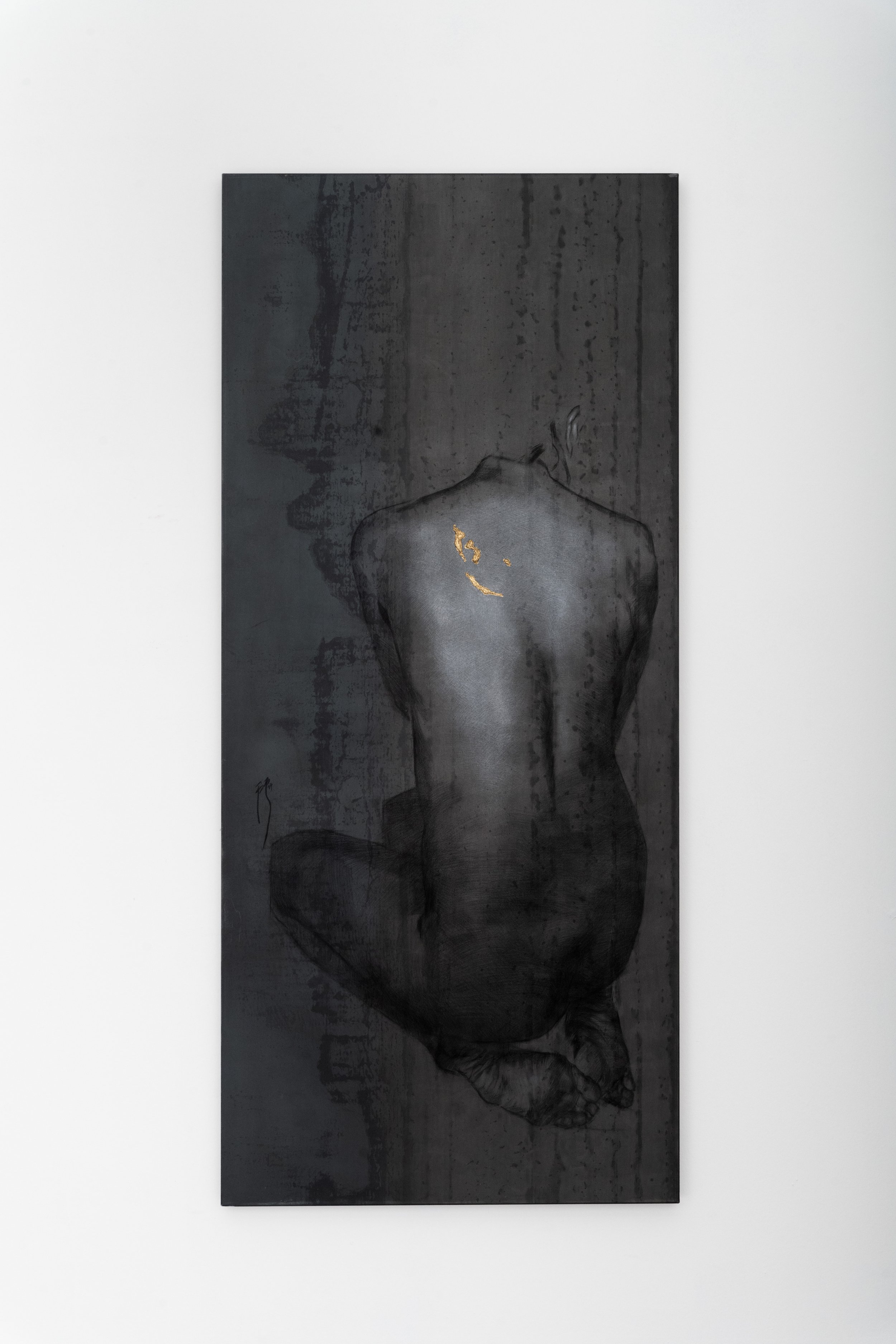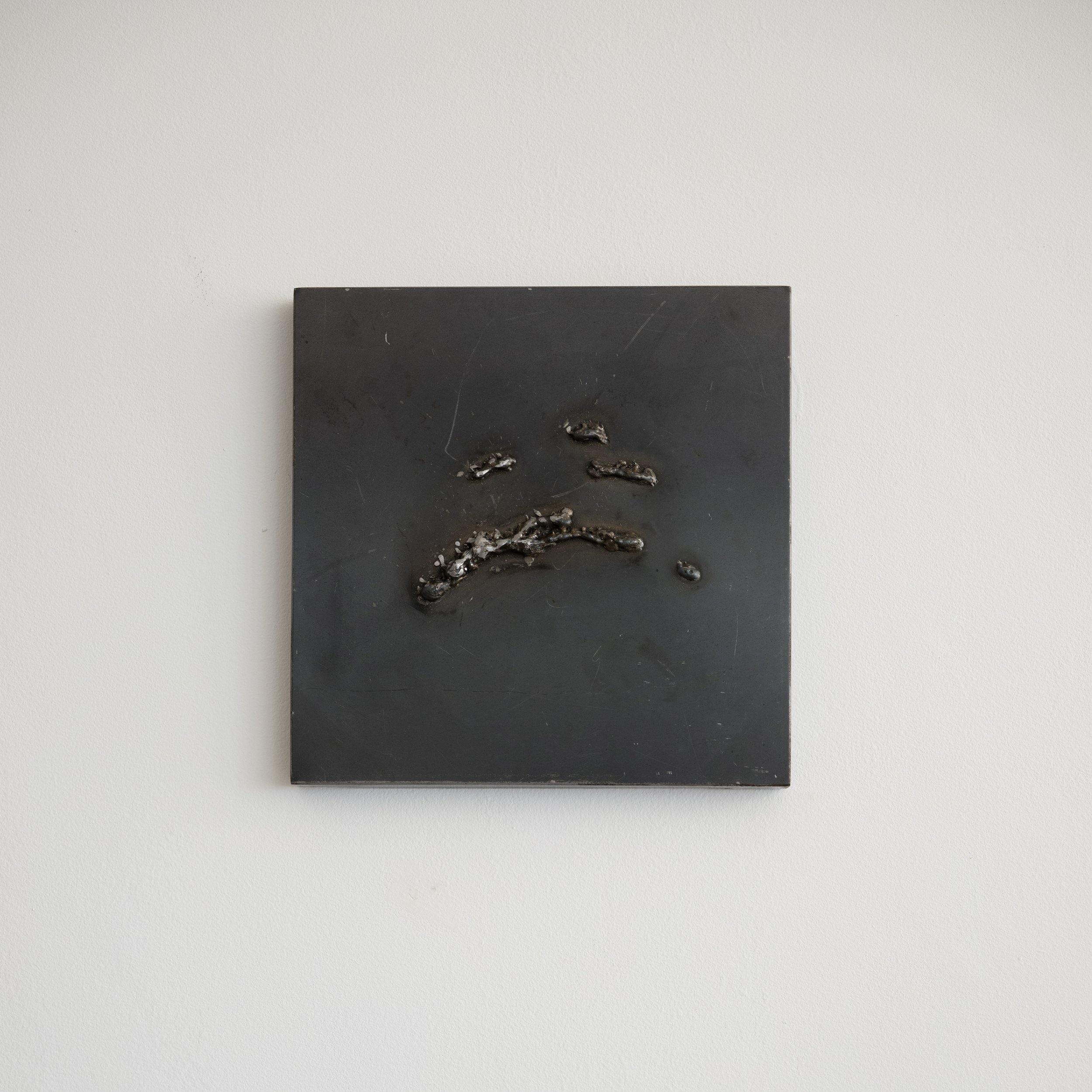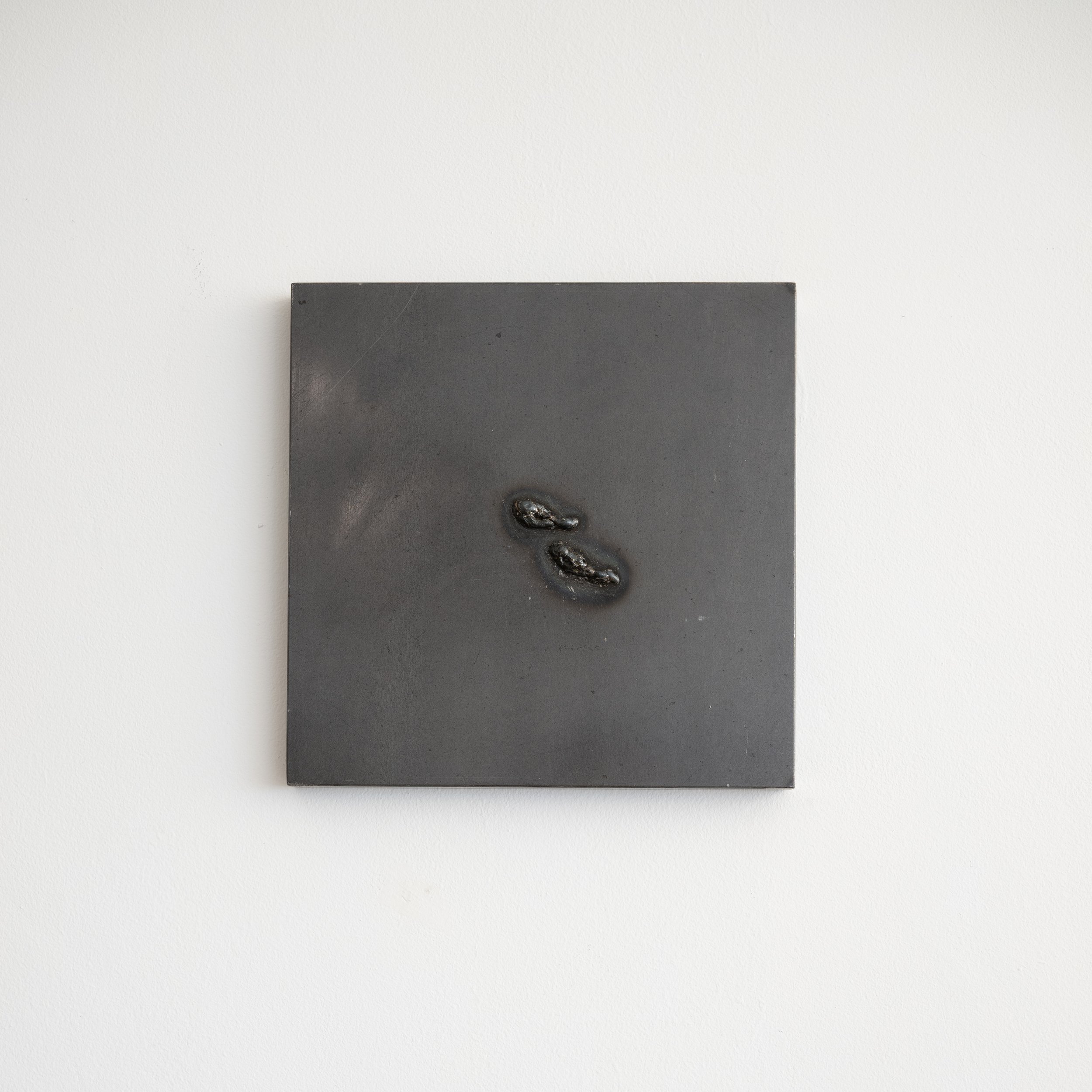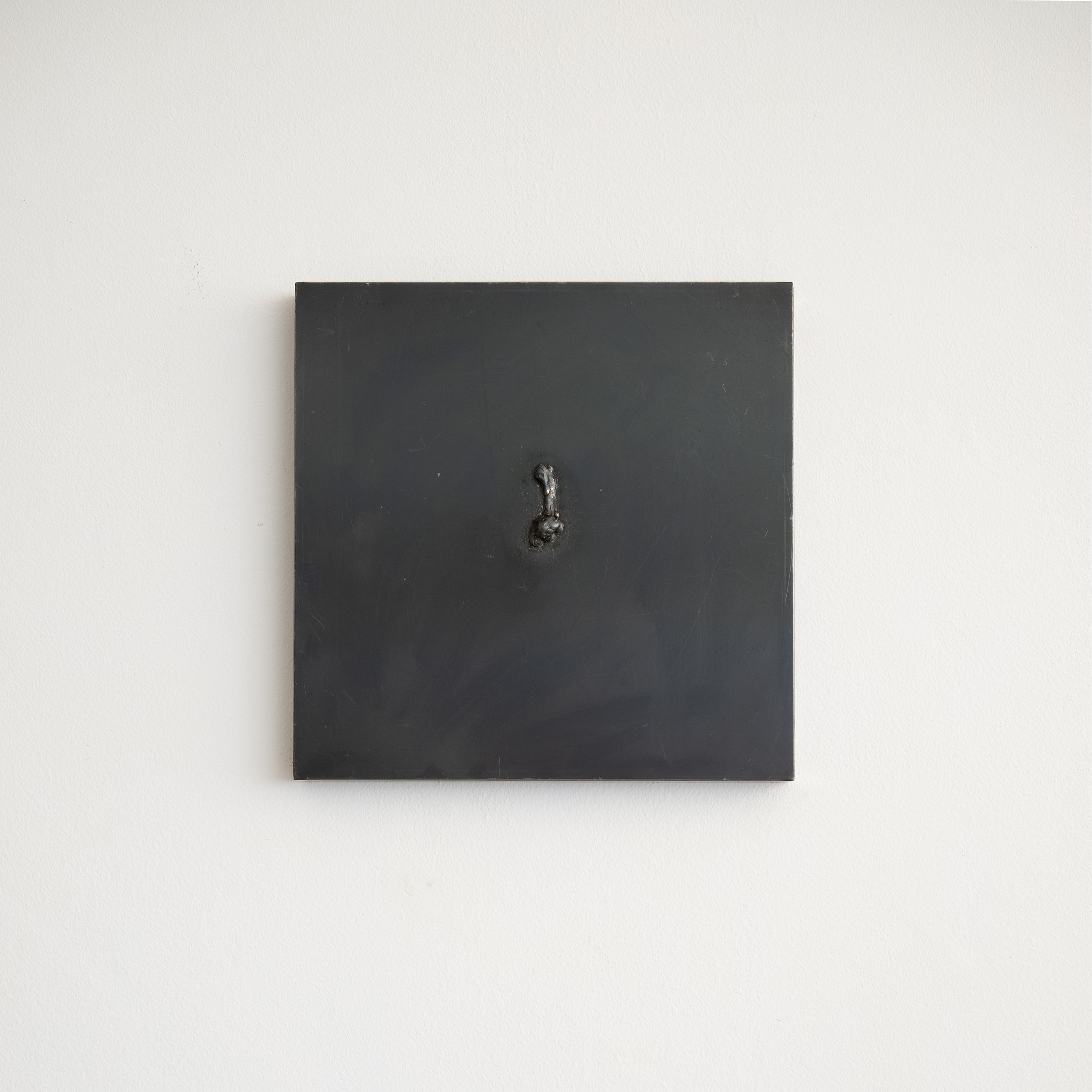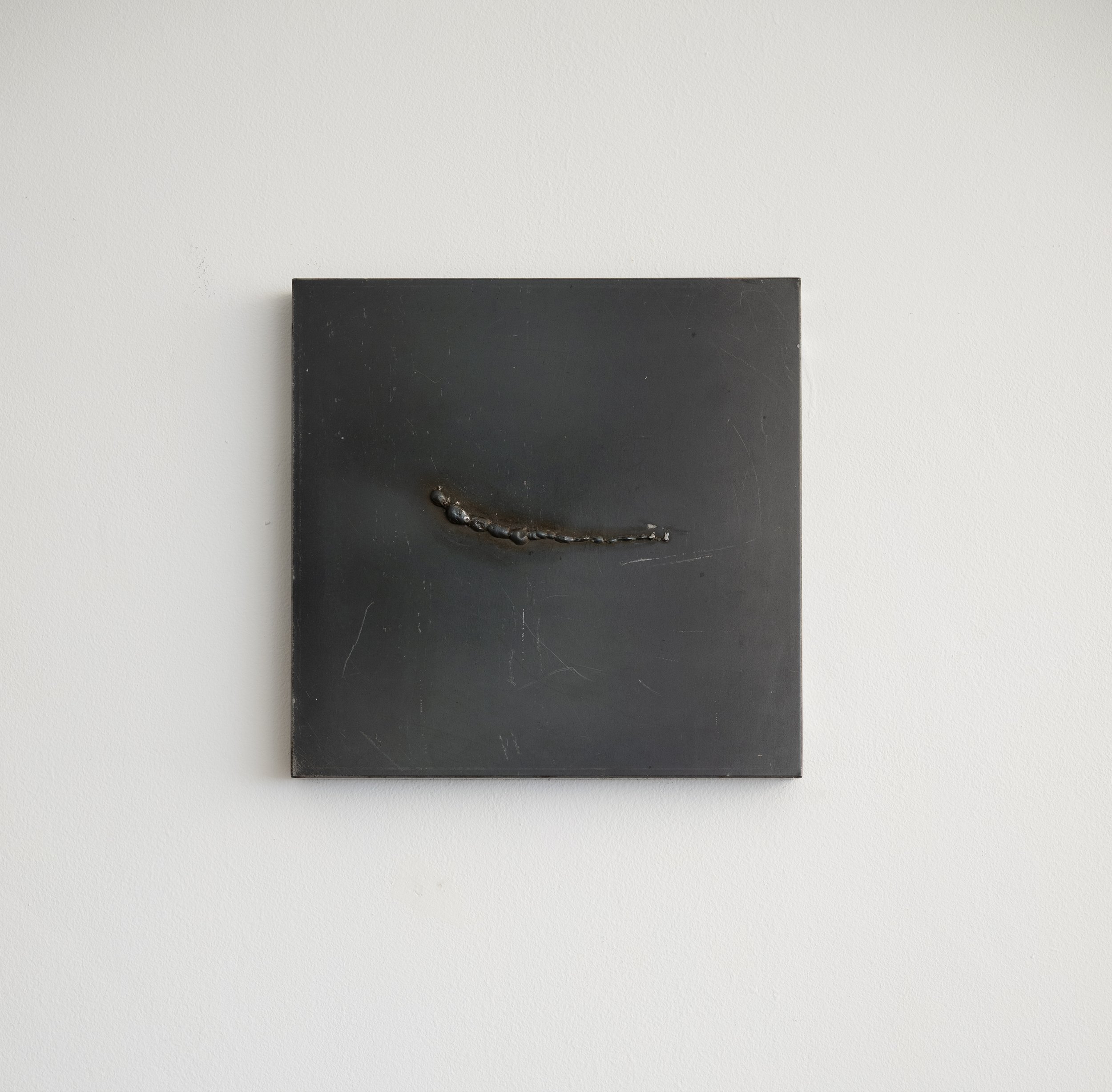SCAR WRITINGS. 2024
Scar Writings
2024 62 mild steel slips, red wire, wood table
On our backs speak a history
2024 Charcoal and chalk on mild steel, gold leaf
On our skin, time traverses and leave marks. Sometimes, they leave scars from wounds that puncture, cause pain, mark identity, surfacing as scars which stain us, mark us, map us. They are symbols of growing pains, stories marked on our skin, which we carry on our bodies.
Cultural conversations over keloids have been framed as a medical disorder (Limandjaja, 2020), shameful aesthetic defect, as well as a cultural imprint, an autograph of ‘social skin’, a waning indigenous practice, a beauty choice through the act of scarification, and as pride. The incidences of societies with keloid have been observed in Asia, Australia, and Africa. The existence of keloid scars has been acknowledged as early as approximately 3000 B.C. by Edwin Smith Papyrus, describing Egyptian Medical Practices. The ‘cheloïde’ or ‘keloïde’ in references the Greek word ‘χηλi’ (khçlçé) for crab’s claw and the suffix -oid meaning ‘like’, describing the claw-like extensions and the superficial-spreading of the invasive growth. In Singapore, Dr Tey Hong Liang, head of National Skin Centre’s research department, invented the near-painless micro-needle patch as alternative treatment process for patients. NSC manages more than 5000 keloid cases a year (as reported in 2015). In Singapore, where scars are often seen as ugly markings of pain, that need to be hidden, removed, cured, contrasts with the pride carried by African societies. Perhaps, pain and pride are just two sides of the same coin, where each reflects the other; one can't exist without the other.
Keloid scars form as a result of an overgrowth of tissue at the site of a healed skin injury. Unlike regular scars that might lighten or minimize over time and are not genetic in nature, keloids may continue to darken and grow and are a genetic feature, suggesting an ever-present reminder of scars that bind a family together. It is like a healing process which forgot to stop, causing more pain and grief on its bearer, as it crawls across the skin like a drawing.
New works Scar Writings (2024) translates the 62-line text in The scars that write us (2018) into metal welded marks on mild steel, a metaphor for the power of language etched themselves onto the skin of art and its artist. These mild steel slips are bounded together like a Chinese traditional bamboo scroll, harkening to the weight of tradition carried, read, and heavy. Our backs speak a history (2024) visually draws from the legend of Yüe Fei, whose mother tattooed on his back a four-character proverb “Utmost”, “Loyalty”, “Serve”and “Nation” when he rejected the position of general offered by a traitor pirate chief Yang Yao. What are the weight and responsibilities which an artist carry? What scars are etched onto our backs? What do we deny that speaks to our values and aspirations? The gold-leaf keloid marks on my back and body consider these thoughts.
THE SCARS THAT WRITE US. 2018
President’s Young Talents Exhibition 2018 People’s Choice Award, Singapore Art Museum.
The scars that write us, part one of installation of weldings on steel plates, Singapore Art Museum, 2019
Keloid scars form as a result of an overgrowth of tissue at the site of a healed skin injury. Unlike regular scars that might lighten or minimise over time and are not genetic in nature, keloids may continue to darken and grow and are a genetic feature, suggesting an ever present reminder of scars that bind a family together. The scars that write us adopts the keloid scar as its reference and attempts to provide a narrative from the point of scar carriers.
Entering into a dark, quietened space–one that muffles the footsteps as you traverse its expanse–a visitor’s first encounter with The scars that write us by Yanyun Chen is perceived rather than seen; feeling almost deferential, one might experience a sense of anticipation, curiosity, and uncertainty for what lies ahead, obscured.
The work’s presentation can be described as unfolding in three sections: near, far, and wide. It is meant to address the spatial proximity and imagined familiarity audiences have with as intimate a space as physical markings upon the flesh of its host. It also endeavours to provide a space to consider the unregistered contemplations of scar bearers.
Slim metal plates that hug the wall greet you as you round the first corner of the gallery. Sidling alongside them, you are confronted by globular, bead, band or worm-like impressions, lightly burnished to appear grafted upon their metal surfaces. Beneath these plates, with their welded keloid designs, lie writings– hand-written reflections in first person–that allude to the experiences of these scar owners—family members, who like the artist have lived experiences of strangers’ unwelcomed acquaintencing of themselves with the scars worn by her family.
Rounding the next corner leads you to a set of partitioned ‘stalls’. Within each stall is housed a life-sized sheet that carries ghostly shadows marking out parts of the artist’s body. These are the areas where the keloids reside on the body of the artist and her relations. The visitor, who is prevented from approaching the delicate charcoal drawings, is made instead to strain their eyes in order to identify the outline and contours of the figure. In conversation with these figures are gold leaf reliefs of scars and keloids reapplied to the artist’s body, as she carries the stories and feelings of her family’s scars into the final section of the installation.
The scars that write us, part three of installation of keloid relief on steel plates and writings (collaboration with Dr. Jeremy Fernando), Singapore Art Museum, 2019
The final section of the gallery is dedicated to wounds, scars, markings and traumas of all kinds. Unfolding as a series of writings by the artist in collaboration with writer Jeremy Fernando, this space calls for our reflecting on the body, trauma, remnants, and the human condition.
The scars that write us is an installation that concerns marks and scars; illness and injury; mind and body; you and everyone. Andrea Fam, Assistant Curator of Singapore Art Museum 2018, with photographs by Joseph Nair




